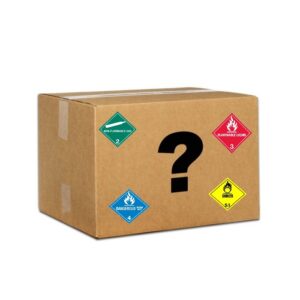
The definition of the term “hazardous materials incident” may be broader than you believe. Not all incidents are related to release of the dangerous good such as a chemical spill or a fire caused by a defective lithium battery. Even an error that creates a risk of an incident may be reported – such as the shipping of undeclared dangerous goods. The issue is prevalent enough that the Pipeline and Hazardous Materials Safety Administration (PHMSA) has created a campaign promoting more careful examination of packages for potential hazmat/dangerous goods. The name of the program gives the clearest instruction for preventing the problem at hand: Check the Box!
The need to follow Check the Box guidelines has never been greater, due to the coronavirus outbreak that has had a tremendous impact on the world and our supply chain. Everyone – right from hazmat employees who are working on the frontlines to compliance managers – needs to do their part so that hazardous materials are properly classified, identified, packaged, marked, labeled, and documented prior to shipping.
Hazardous Materials in Day-to-Day Life and Online IATA Training
We mentioned earlier that not all hazardous materials incidents are the same. Similarly, Check the Box reminds us that not all dangerous goods are as obviously noticeable as, for example, drums containing flammable liquids or compressed gas cylinders such as industrial size fire extinguishers. In fact, many household items either contain hazardous materials or may themselves be considered hazardous materials. Lithium batteries, aerosol sprays, and adhesives – all common items used in daily life – are listed in the US Department of Transportation’s (DOT) website for the campaign.
As the Check the Box FAQ page states, the designation of “hazmat” simply applies to anything that may “pose an unreasonable risk to health, safety, and property when transported in commerce.” The truth is that you can find many examples of this in your own home. These include the medicine you keep for colds, the chemicals you use for cleaning around the house, and the batteries that power your electronics. Even painting materials, fire extinguishers, and nail polish removers fit the definition of a hazardous material.
Checking for Undeclared Dangerous Goods is Important
It is crucial for hazmat employees to make sure that all packages containing hazardous materials are correctly classified, identified, packaged, marked, labeled and documented when applicable. Anyone involved in the transportation of hazardous materials in commerce needs to know what exactly is contained in the packages they are handling and shipping before offering to carrier. Undeclared dangerous goods increase the risk of a hazmat incident.
Check the Box encourages shippers to review the Safety Data Sheet (SDS) of the items that will be shipped. The SDS provides information that can assist in the classification and identification steps in order to locate the articles/substances on the Hazardous Materials Table, which provides further instructions on how these products must be packaged, marked, labeled and documented if required. Communication is critical, and this is accomplished by providing the appropriate marks, labels and shipping papers for the package(s) that will be offered for transportation in commerce because they would then convey the hazardous nature of the package’s contents. All this is vital to preventing accidents that can require emergency response, and it all starts with the simple precaution of checking the box.
Impact of COVID-19 Pandemic on Hazmat Shipping and Check the Box Protocol
The pandemic has caused a shortage of lifesaving medications and essential medical devices in many places. These items are being transported to different places in the United States, as well as to countries in other parts of the world.
Many of these items that are being shipped – disinfectants, raw materials for medications, components of medical equipment, and so on – may hazardous in nature. So, they need to be properly classified according to the risks they pose and the hazard class they come under, so that they can be packaged and transported safely.
If an item is incorrectly classified, improperly packaged, or mistakenly marked as a non-hazardous item, and if the supply chain compliance managers, hazmat employees and carriers fail to notice it, it can result in a hazmat incident. The consequences of the incident might be three-fold.
- Property damage
- Injuries and/or deaths
- Legal consequences for failing to comply with hazmat regulations
At a time when the economy is slowing down, no company can afford to face the consequences – financial or otherwise – of a hazmat incident.
To avoid such incidents and the resulting consequences, hazmat employees who are in charge of storing, classifying, identifying, packing, marking, labeling, preparing dangerous goods documentation, and transporting hazardous items must complete dangerous goods training in order to comply with federal and international regulations. As an example of crucial hazmat / dangerous goods training is initial dangerous goods training for those employees who will be offering dangerous goods by air. Online IATA training programs at a time like now that social distancing is required and following Check the Box guidelines properly will make the necessary difference in avoiding on undeclared dangerous good shipment for air transport. Aside from completing initial training, hazmat employees must also be required to undergo recurrent training programs at least once every two years, so that they can stay updated on all the latest regulations.
Online IATA Training Programs for Hazmat Employees
As the COVID-19 pandemic continues, we realize that our mission to keep people safe is more important than ever. Even as businesses transition to operating remotely, we understand that supply chain services must continue. Our team is here to support the shippers, carriers, freight-forwarders, and operators who must carry on during these trying times. Our reliable solutions will continue to support our customers requiring online IATA training or any other mode of transport they might be faced with.
Our self-paced online training and instructor-led webinars provide safe, travel-free options to complete your dangerous goods training from the comfort of your home.
We’re here to help with regulatory technical support Monday-Friday from 8:30 AM – 5:00 PM EDT at no cost to you.
Need help selecting the right online hazmat training course for your training needs? Our modal and multimodal courses combine lessons containing the latest regulatory information with interactive exercises and quizzes to facilitate compliance with regulatory training requirements. Call us at (844) 532-7634 / (609) 860-0300 or contact us online, and we’ll be glad to help you!
